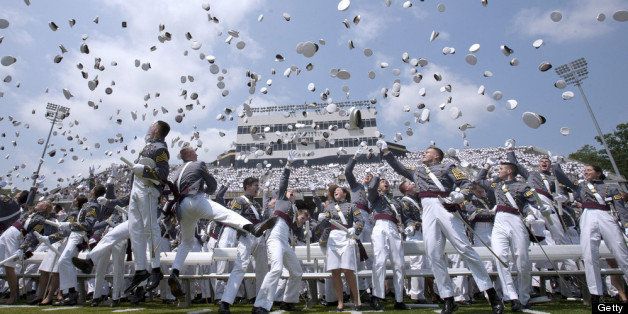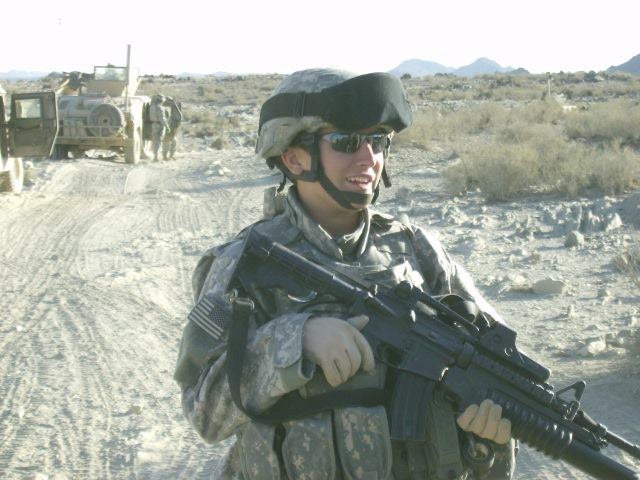
On Sept. 11, 2001, most of the graduates of the class of 2013 were 10 years old. When the U.S. invaded Iraq in 2003, they weren't yet teenagers. The decade since has brought a changed world -- and two wars -- for this year's graduates from colleges around the country, and perhaps none feel this as keenly as those at the U.S. military academies.
"The Army you enter today is emerging –- and in many ways recovering –- from more than a decade of war in Iraq and Afghanistan," Chuck Hagel said at West Point's commencement on May 25. "You will have the responsibility of helping shape it and you will have the responsibility of helping lead it, and this all during a very complicated and uncertain time in the world."
The Air Force Academy, Naval Academy and Coast Guard Academy held their commencements at the end of May, and the U.S. Merchant Marine Academy will graduate its class of 2013 on June 17. As the schools evolve to keep up with the seismic changes in U.S. defense, a snapshot of the class of 2013 gives a look into the future of our military and those who will lead it.
U.S. Military Academy, West Point
Class of 2013:
- 1,000 graduates
- 137 women, 863 men
- 55 African Americans, 70 Asian/Pacific Islanders, 95 Hispanics, 5 Native Americans
- 15 foreign graduates, representing Colombia, Georgia, Honduras, Latvia, Lebanon, Nicaragua, Panama, Peru, Philippines, Poland, Romania, Slovenia, Taiwan, Thailand and Tunisia
Class of 2003:
- 846 graduates
- 124 women, 722 men
- 55 African Americans, 44 Asian/Pacific Islanders, 68 Hispanics, 1 Native American
- 7 foreign graduates, representing Estonia, Lithuania, Nicaragua, Republic of Korea, Romania, Slovenia and Turkey
Students choose from 44 majors at West Point. Fancis DeMarco Jr., the school's public affairs specialist, said the fundamental curriculum remains largely the same: highly focused on engineering. Every graduate leaves West Point with a Bachelor of Science degree and a five-year commitment as an officer in the U.S. Army.
U.S. Naval Academy
Class of 2013:
- 1,047 graduates
- 206 women, 841 men
- 65 African Americans, 43 Asian/Pacific Islanders, 138 Hispanic, 4 Native American
- 16 foreign graduates, representing Belize, Georgia, Guatemala, Korea, Lebanon, Montenegro, Panama, Philippines, Poland, Singapore, South Africa, Taiwan and Tunisia
Class of 2003:
- 969 graduates
- 148 women, 821 men
- 52 African Americans, 41 Asian/Pacific Islanders, 72 Hispanic, 9 Native American
- 8 foreign graduates, representing Philippines, Estonia, Singapore, Cameroon and Thailand
The Naval Academy recently added cyber courses to its curriculum, said Colleen Roy, public affairs specialist. Beginning in 2015, all midshipmen will be required to take two of these courses as part of the core curriculum. The class of 2016 will have the option of a "Cyber Operations" major -- "an interdisciplinary major that covers the wide scope of cyberspace and related operations, both technical and non-technical," Roy said.
U.S. Air Force Academy
Class of 2013:
- 1,049 graduates
- 217 women, 832 men
- 56 African Americans, 48 Asian/Pacific Islanders, 98 Hispanic, 8 Native American
- 11 foreign graduates, representing Colombia, Ghana, Lithuania, Peru, the Philippines, Poland, Serbia, Slovenia, Taiwan, Thailand and Trinidad
Class of 2003:
- 995 graduates
- 139 women, 856 men
- *Racial/ethnic breakdown not available
- 10 foreign graduates, representing Oman, Jordan, Bosnia, Bulgaria, Pakistan, Ukraine, Latvia, Korea and Croatia
John Van Winkle, Air Force Academy public affairs officer, said the school's curriculum is constantly evolving, "for what we project they will need as Air Force officers in 2014, as well as 2024 and 2034."
The Air Force Academy's academic core consists of courses from behavioral sciences to foreign languages to aeronautical, mechanical and astronautical engineering, as well as more traditional military strategic studies.
Graduates' commitments range from five years of active duty to 10 years -- after "earning their wings" -- for those who enter pilot training.
U.S. Coast Guard Academy
Class of 2013:
- 219 graduates
- 63 women, 156 men
- 3 African Americans, 6 Asian/Pacific Islanders, 17 Hispanics, 2 Native American
- 4 foreign graduates, representing Tunisia, Honduras, Belize and Lithuania
Class of 2003:
- 186 graduates
- 52 women, 134 men
- 7 African Americans, 5 Asian/Pacific Islanders, 13 Hispanics, 2 Native Americans
- 5 foreign graduates, representing St. Lucia, Croatia, Malta, Jamaica and Palau
Graduates of the Coast Guard academy will serve five years in the U.S. Coast Guard.
At their commencement, Vice President Joe Biden acknowledged the changes that made the class of 2013's experience different from that of the generations before them, saying, "This is not your father's Coast Guard."
U.S. Merchant Marine Academy
Class of 2013:
- 291 graduates
- 30 women, 261 men
- 13 African Americans, 12 Asian/Pacific Islanders, 16 Hispanics, 1 Native American
- Foreign graduates representing Republic of Panama, Malaysia, South Korea and Singapore
Class of 2003:
- 276 graduates
- *Number of women, men not available
- 5 African Americans, 12 Asian/Pacific Islanders, 14 Hispanics, 3 Native American
- *Number of foreign graduates and their countries not available
Marcie Katcher, director of external affairs at the U.S. Merchant Marine Academy, noted that it was the first federal service academy to admit women, in 1974. About a quarter of graduates enter active duty.
To keep up with rapid changes in the industry such as rising demands for alternative power and maritime security programs, the school has been provided with more than $300 million in funding over the past four years to modernize its facilities
As Van Winkle, the Air Force officer, put it: "No underwater basket weaving here."
Clarification: This article has been updated to clarify that the U.S. Merchant Marine Academy has been provided $300 million in funding over the past four years.
